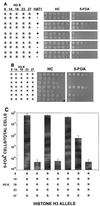Type B histone acetyltransferase Hat1p participates in telomeric silencing
- PMID: 10982821
- PMCID: PMC86239
- DOI: 10.1128/MCB.20.19.7051-7058.2000
Type B histone acetyltransferase Hat1p participates in telomeric silencing
Abstract
Hat1p and Hat2p are the two subunits of a type B histone acetyltransferase from Saccharomyces cerevisiae that acetylates free histone H4 on lysine 12 in vitro. However, the role for these gene products in chromatin function has been unclear, as deletions of the HAT1 and/or HAT2 gene displayed no obvious phenotype. We have now identified a role for Hat1p and Hat2p in telomeric silencing. Telomeric silencing is the transcriptional repression of telomere-proximal genes and is mediated by a special chromatin structure. While there was no change in the level of silencing on a telomeric gene when the HAT1 or HAT2 gene was deleted, a significant silencing defect was observed when hat1Delta or hat2Delta was combined with mutations of the histone H3 NH(2)-terminal tail. Specifically, when at least two lysine residues were changed to arginine in the histone H3 tail, a hat1Delta-dependent telomeric silencing defect was observed. The most dramatic effects were seen when one of the two changes was in lysine 14. In further analysis, we found that a single lysine out of the five in the histone H3 tail was sufficient to mediate silencing. However, K14 was the best at preserving silencing, followed by K23 and then K27; K9 and K18 alone were insufficient. Mutational analysis of the histone H4 tail indicated that the role of Hat1p in telomeric silencing was mediated solely through lysine 12. Thus, in contrast to other histone acetyltransferases, Hat1p activity was required for transcriptional repression rather than gene activation.
Figures







References
-
- Adams A, Gottschling D E, Kaiser C A, Stearns T. Methods in yeast genetics. Cold Spring Harbor, N.Y: Cold Spring Harbor Laboratory Press; 1997.
-
- Adams C R, Kamakaka R T. Chromatin assembly: biochemical identities and genetic redundancy. Curr Opin Genet Dev. 1999;9:185–190. - PubMed
-
- Aparicio O M, Billington B L, Gottschling D E. Modifiers of position effect are shared between telomeric and silent mating-type loci in S. cerevisiae. Cell. 1991;66:1279–1287. - PubMed
Publication types
MeSH terms
Substances
Grants and funding
LinkOut - more resources
Full Text Sources
Molecular Biology Databases
